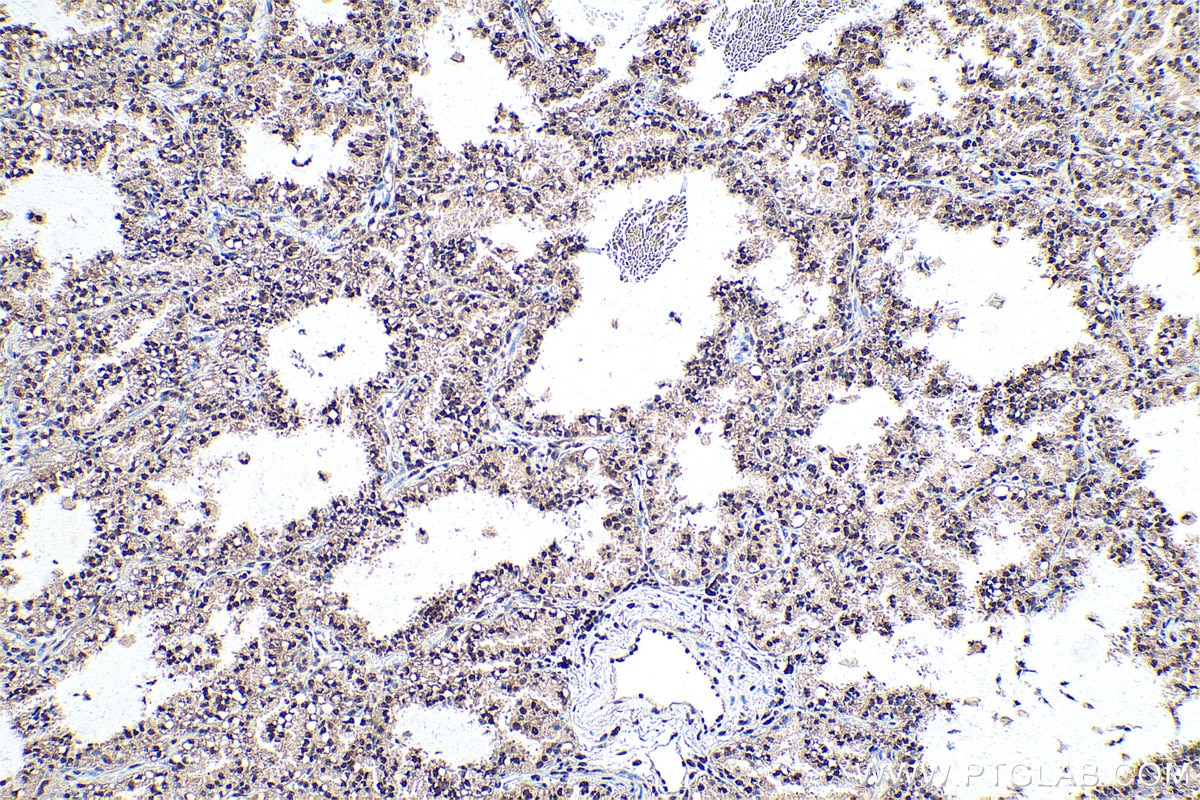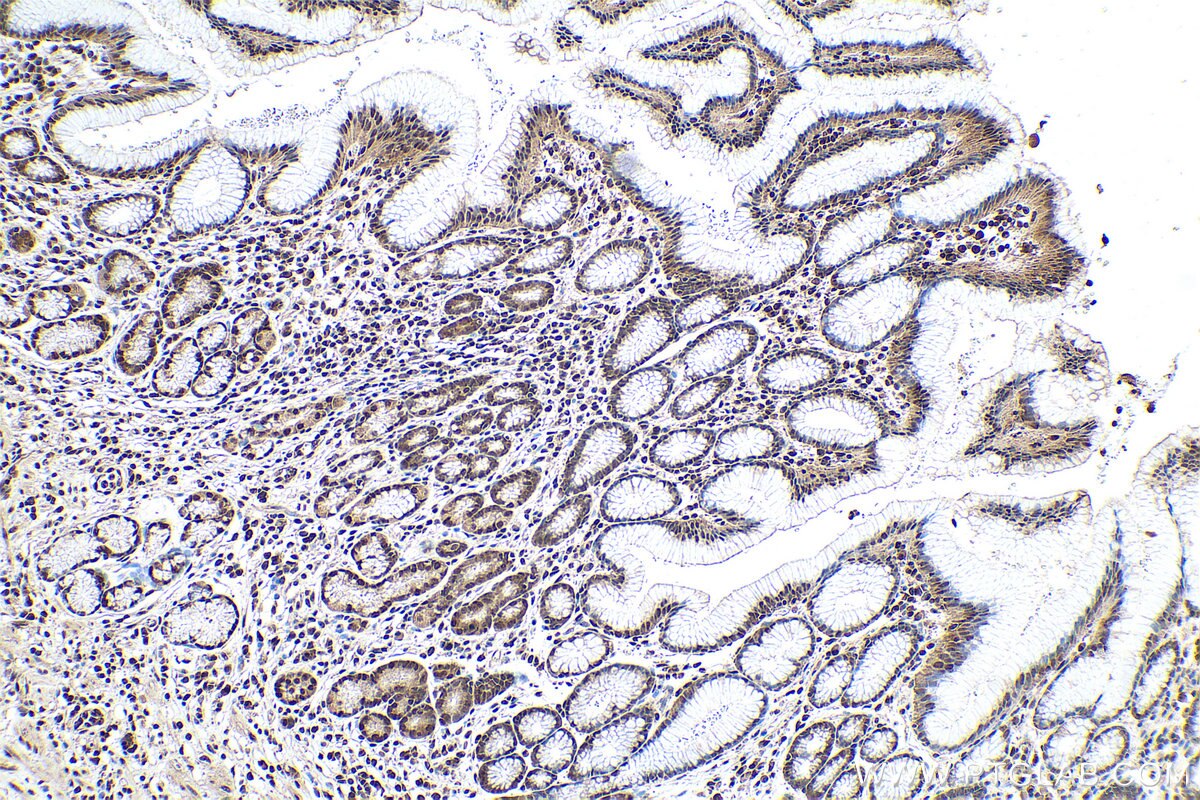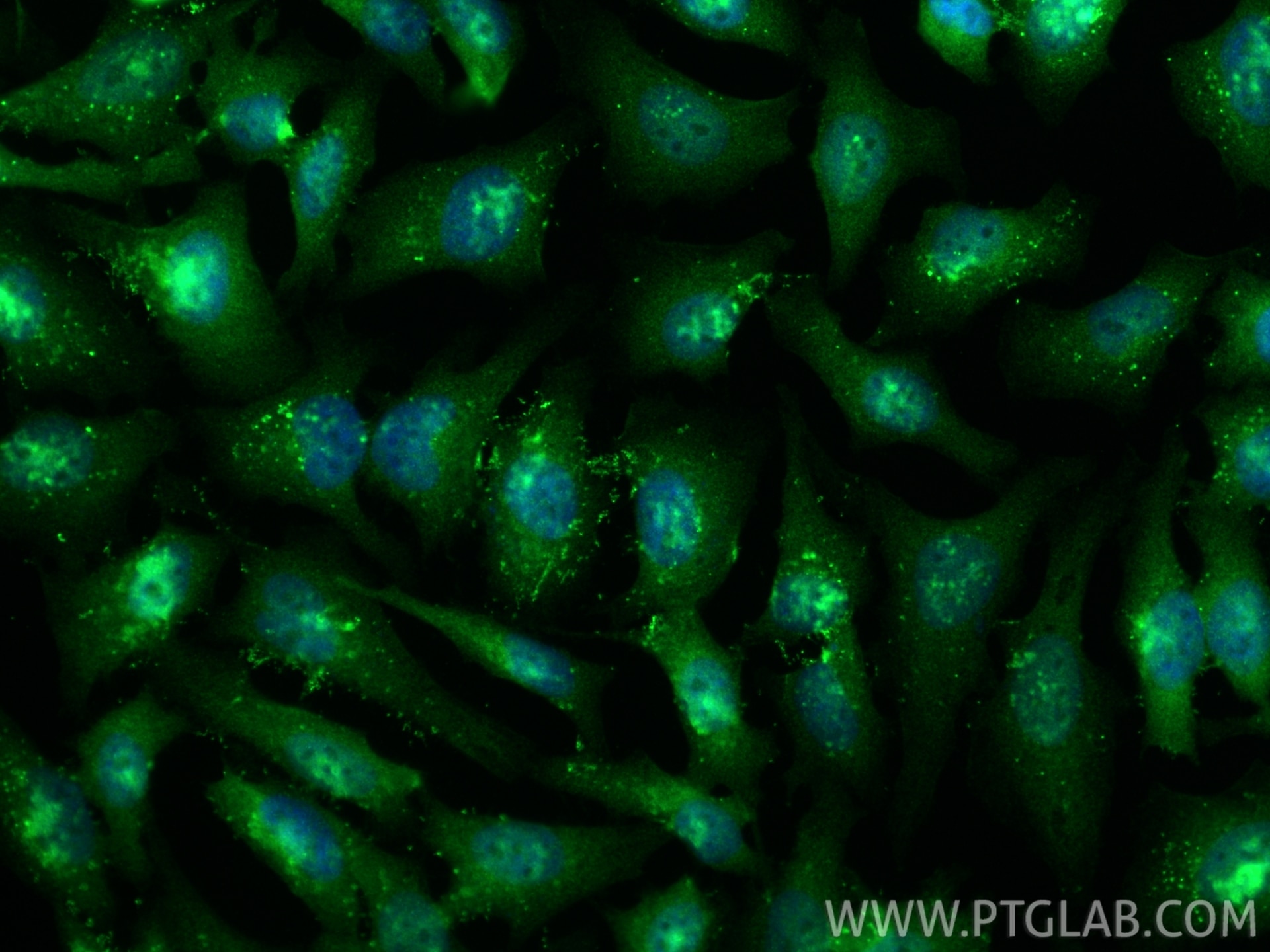Tested Applications
| Positive WB detected in | HeLa cells, mouse brain tissue, Jurkat cells |
| Positive IP detected in | HeLa cells |
| Positive IHC detected in | human lung cancer tissue, human liver cancer tissue, human stomach cancer tissue Note: suggested antigen retrieval with TE buffer pH 9.0; (*) Alternatively, antigen retrieval may be performed with citrate buffer pH 6.0 |
| Positive IF/ICC detected in | HeLa cells |
| Positive FC (Intra) detected in | A431 cells, HeLa cells |
Recommended dilution
| Application | Dilution |
|---|---|
| Western Blot (WB) | WB : 1:2000-1:16000 |
| Immunoprecipitation (IP) | IP : 0.5-4.0 ug for 1.0-3.0 mg of total protein lysate |
| Immunohistochemistry (IHC) | IHC : 1:1000-1:4000 |
| Immunofluorescence (IF)/ICC | IF/ICC : 1:200-1:800 |
| Flow Cytometry (FC) (INTRA) | FC (INTRA) : 0.25 ug per 10^6 cells in a 100 µl suspension |
| It is recommended that this reagent should be titrated in each testing system to obtain optimal results. | |
| Sample-dependent, Check data in validation data gallery. | |
Published Applications
| KD/KO | See 2 publications below |
| WB | See 7 publications below |
| IP | See 2 publications below |
Product Information
19809-1-AP targets RTCB-Specific in WB, IHC, IF/ICC, IP, ELISA applications and shows reactivity with human, mouse, rat samples.
| Tested Reactivity | human, mouse, rat |
| Cited Reactivity | human, pig |
| Host / Isotype | Rabbit / IgG |
| Class | Polyclonal |
| Type | Antibody |
| Immunogen |
CatNo: Ag13836 Product name: Recombinant human C22orf28 protein Source: e coli.-derived, PGEX-4T Tag: GST Domain: 159-505 aa of BC000151 Sequence: GVIPMNAKDLEEALEMGVDWSLREGYAWAEDKEHCEEYGRMLQADPNKVSARAKKRGLPQLGTLGAGNHYAEIQVVDEIFNEYAAKKMGIDHKGQVCVMIHSGSRGLGHQVATDALVAMEKAMKRDKIIVNDRQLACARIASPEGQDYLKGMAAAGNYAWVNRSSMTFLTRQAFAKVFNTTPDDFDLHVIYDVSHNIAKVEQHVVDGKERTLLVHRKGSTRAFPPHHPLIAVDYQLTGQPVLIGGTMGTCSYVLTGTEQGMTETFGTTCHGAGRALSRAKSRRNLDFQDVLDKLADMGIAIRVASPKLVMEEAPESYKNVTDVVNTCHDAGISKKAIKLRPIAVIKG Predict reactive species |
| Full Name | chromosome 22 open reading frame 28 |
| Calculated Molecular Weight | 55 kDa |
| Observed Molecular Weight | 55 kDa |
| GenBank Accession Number | BC000151 |
| Gene Symbol | RTCB |
| Gene ID (NCBI) | 51493 |
| RRID | AB_10695047 |
| Conjugate | Unconjugated |
| Form | Liquid |
| Purification Method | Antigen affinity purification |
| UNIPROT ID | Q9Y3I0 |
| Storage Buffer | PBS with 0.02% sodium azide and 50% glycerol, pH 7.3. |
| Storage Conditions | Store at -20°C. Stable for one year after shipment. Aliquoting is unnecessary for -20oC storage. 20ul sizes contain 0.1% BSA. |
Background Information
RTCB (also known as HSPC117, C22orf28, FAAP, and D10Wsu52e) is a essential subunit of the tRNA ligase complex, which is localized in both the cytoplasm and nucleus, and is involved in RNA repair and stress-induced splicing. As a multifunctional protein, RTCB also serves as a cell adhesion protein and plays an important role in embryo and placenta development. Recently, RTCB has been identified as an UPR RNA ligase that catalyzes unconventional XBP1 mRNA splicing. This antibody specifically recognizes endogenous RTCB protein. (25087875)
Protocols
| Product Specific Protocols | |
|---|---|
| FC protocol for RTCB-Specific antibody 19809-1-AP | Download protocol |
| IF protocol for RTCB-Specific antibody 19809-1-AP | Download protocol |
| IHC protocol for RTCB-Specific antibody 19809-1-AP | Download protocol |
| IP protocol for RTCB-Specific antibody 19809-1-AP | Download protocol |
| WB protocol for RTCB-Specific antibody 19809-1-AP | Download protocol |
| Standard Protocols | |
|---|---|
| Click here to view our Standard Protocols |
Publications
| Species | Application | Title |
|---|---|---|
Nat Commun Reprogramming of microRNA expression via E2F1 downregulation promotes Salmonella infection both in infected and bystander cells. | ||
J Biol Chem The cyclic phosphodiesterase CNP and RNA cyclase RtcA fine-tune noncanonical XBP1 splicing during ER stress.
| ||
Life Sci Alliance Stress-induced tyrosine phosphorylation of RtcB modulates IRE1 activity and signaling outputs. | ||
J Immunol The RNA-Splicing Ligase RTCB Promotes Influenza A Virus Replication by Suppressing Innate Immunity via Interaction with RNA Helicase DDX1 |
Reviews
The reviews below have been submitted by verified Proteintech customers who received an incentive for providing their feedback.
FH Megan (Verified Customer) (08-07-2025) | I used this antibody to verify a knockdown of RtcB in Hek293T cells and it worked well. Gave a specific band.
|
FH Ilham (Verified Customer) (08-06-2024) | It works very well - the AB was diluted 1:2000 in 5% BSA -chemiluminescence blots using the ChemiDoc Imaging System.
|
























